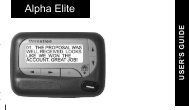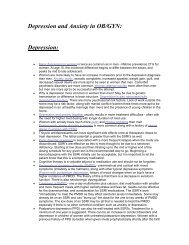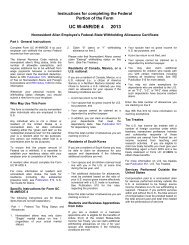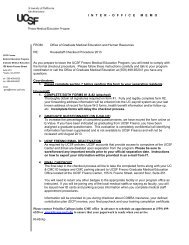developmental & behavioral screening tool manual ... - UCSF Fresno
developmental & behavioral screening tool manual ... - UCSF Fresno
developmental & behavioral screening tool manual ... - UCSF Fresno
You also want an ePaper? Increase the reach of your titles
YUMPU automatically turns print PDFs into web optimized ePapers that Google loves.
DEVELOPMENTAL &BEHAVIORAL SCREENINGTOOL MANUAL FORPROVIDERS
TABLE OF CONTENTSSUGGESTED TOOLSA. ASQ - 3 2B. ASQ-SE 3C. BITSEA 4D. Infant Development Inventory 3-18 months 5E. ITSEA 6F. PEDS:DM - Birth to 9 years 7G. PEDS:DM - Birth to 7-11 years 8H. POINT 92SUGGESTED FREE TOOLSA. EPDS 10B. M-CHAT 10C. PSI 1210OTHER TOOLS FOR DEVELOPMENTAL SCREENING13LIST OF CHILDHOOD DEVELOPMENTAL TOOLSREFERENCES1516
D E V E L O P M E N T A L & B E H A V I O R A L S C R E E N I N G T O O L M A N U A LSUGGESTED TOOLSScreening ToolASQ-3 (Ages and Stages Questionnaire-3 rdEdition) 1-66 monthsDescriptionThe ASQ-3 is a parent-completed questionnaire intended to screenyoung children for <strong>developmental</strong> delays. Each questionnairecontains questions <strong>screening</strong> areas of communication, gross motor,fine motor, problem solving, and personal-social skills.Standardization The ASQ-3 was standardized in a national sample of 12,695children.ReliabilityTest-retest reliability was found to be .91, and inter-rater reliabilitywas found to be .92.Validity The ASQ-3 was found to have excellent validity: .82-.88.AccuracyCost:$249.95 ASQ-3 Starter Kit (one-time cost)Includes: ASQ-3 User’s Guide, ASQ 3 Quick Start Guide, and a photocopiable print master set of21 questionnaires and scoring sheets, as well as a CD-ROM with printable PDF questionnaires.Ordering Information:www.brookespublishing.com/asq1-800-638-3775The ASQ-3 was found to have a sensitivity of 86% and a specificityof 85%.The ASQ-3 is effective and affordable. It gives reliable and accurate results, is easy to use, requires littletraining, is available in several languages, and includes follow-up activities.The ASQ-3 can be used in conjunction with the ASQ:SE, but is not required.P A G E 2
D E V E L O P M E N T A L & B E H A V I O R A L S C R E E N I N G T O O L M A N U A LScreening ToolDescriptionStandardizationReliabilityASQ-SE (Ages and StagesQuestionnaire:Social-Emotional) 6-60monthsCost:$149 Complete ASQ:SE System (one-time cost)Includes: ASQ:SE User’s Guide, ASQ:SE Quick Start Guide, and a photocopiable print masterset of questionnaires and scoring sheets, as well as a CD-ROM with printable PDFquestionnaires.Ordering Information:www.brookespublishing.com/asq1-800-638-3775The ASQ:SE was created in response to feedback from the ASQfor a <strong>tool</strong> to focus on children’s social and emotional behavior. TheASQ:SE is a parent-completed questionnaire to assess children’ssocial-emotional development.The ASQ:SE was standardized on 3,014 children.Test-retest reliability was 94% and internal consistency ranged from67% - 91%.Validity Concurrent validity ranged from 81% - 95%.Accuracy The ASQ:SE was found to have a sensitivity range of 71% - 85%and specificity range of 90% - 98%.The ASQ:SE is effective and affordable. It gives reliable and accurate results, is easy to use, requireslittle training, is available in several languages, and includes follow-up activities.The ASQ-3 can be used in conjunction with the ASQ:SE, but is not required.P A G E 3
D E V E L O P M E N T A L & B E H A V I O R A L S C R E E N I N G T O O L M A N U A LScreening ToolBITSEA (Brief Infant Toddler SocialEmotional Assessment) 12-36 monthsDescriptionThe BITSEA is a 42-item parent-report that assesses emergingsocial-emotional development.ReliabilityInternal consistency was found to be .65-.80. Inter-rater reliabilitywas found to be .61-.68. Test-retest was found to be .85-.87.Validity The BITSEA was found to have predictive validity of .71.AccuracyCost: (Not Reproducible)$105 BITSEA KitIncludes: BITSEA <strong>manual</strong>, 25 BITSEA Parent Forms, 25 BITSEA Childcare Provider Forms.Ordering Information:www.harcourtassessment.com1-800-211-8378The BITSEA was found to have a sensitivity of 80% - 90% and aspecificity of 80% - 89%.If social-emotional and competency development delays are identified, follow-up with the ITSEA forfurther assessment.P A G E 4
D E V E L O P M E N T A L & B E H A V I O R A L S C R E E N I N G T O O L M A N U A LScreening ToolInfant Development Inventory 3-18 monthsDescriptionThe IDI uses an Infant Development Chart that tracks developmentin 5 areas- social, self-help, gross motor, fine motor and language.Monthly <strong>developmental</strong> milestones on the chart help parents to seea bigger picture of how infants develop. Parents can also report anyquestions or concerns about their baby's health, development,behavior, etc. Professionals may further assess the infant'sdevelopment by observing behaviors and recording them on thechart.StandardizationThe IDI was standardized with 220 children.Reliability Reliability of the IDI was found to be .70.Validity Concurrent validity of the IDI was found to be .69.Accuracy Sensitivity of the IDI was found to be 85%. Specifici as found tobe 77%.Cost: (Not Reproducible)$80 Health Care Starter PackIncludes: 25 IDI parent questionnaires, 25 child development charts, 2 wall charts of childdevelopment.$14 per pad of 25Ordering Information:http://www.childdevrev.comP A G E 5
D E V E L O P M E N T A L & B E H A V I O R A L S C R E E N I N G T O O L M A N U A LScreening ToolDescriptionPOINT (Parents’ Observations of Infants andToddlers) 2-36 monthsA <strong>developmental</strong> rating scale designed to identify young childrenwith potential problems who may be in need of further diagnosticassessment. POINT is a 15-20 minute <strong>screening</strong> of behaviorsdemonstrated by children and observed by either one or twoparents, and/or one or two caregivers, all of whom know the childintimately.Standardization POINT was standardized in 2002-2003 on a national sample of 947English-speaking parents/caregivers and 195 Spanish-speakingparents, taking into consideration gender, race, geographiclocation, socioeconomic level based on parental education, andchronological age of the child. Norms are provided at 2 monthintervals from 2 months through 36 months.ReliabilityInter-rater ReliabilitiesCorrelation between primary parent raterand second parent raterInter-raterReliabilityCoefficient0.7230ValidityAccuracyAverage of correlations between primaryparent rater and center-based caregiver 0.8239raters.08319Correlation between center-basedcaregiver raters0.6300Average of correlations between secondparent rater and center-based ratersThe inter-rater reliability coefficients are generally high. The interraterreliability is somewhat reduced when the second parent,instead of the parent with the primary care-giving responsibilities, isused as the rater. It is reasonable to assume that the secondparent generally has less continuous contact with the child whencompared to the primary care-giving parent or even compared tothe caregiver in a center-based program. Classification reliabilitieswere found to be extremely high.POINT is considered to be valid based on content, relations withother variable, response processes fairness, and absence of bias.POINT is considered to be accurate in identifying children in needof receiving one or more special services.Cost: (Not Reproducible)$205 each for the English or Spanish Basic KitIncludes Manual, Record Forms for Levels 1-6 (12 each level), 1 set of Record Forms in Spanishor English (Dependant upon the main language of the Kit), 1 set of transparent Scoring Mastersfor Levels 1-6 (for English and Spanish Record Forms), Duplication Masters of parentsConference Plan and the Report Card in English and in SpanishOrdering Information:http://pearsonassessments.com/point1-800-627-7271P A G E 9
D E V E L O P M E N T A L & B E H A V I O R A L S C R E E N I N G T O O L M A N U A LSUGGESTED FREE TOOLSScreening ToolCost:EPDS (Edinburgh Postnatal Depression Scale)Description The EPDS was developed to assist primary health profes todetect whether mothers are suffering from postnatal depression. TheEPDS has a maximum score of 30; a score of 10 or more may indicatepossible depression of varying severity.ReliabilityReported to be adequate.ValidityReported to be adequate.Accuracy Sensitivity was found to be 86% and specificity was found to be 78%.FREE DOWNLOADAvailable from:www.dbpeds.orgPerinatal depression has substantial personal consequences and interferes with quality of childrearing,adversely affecting parent-child interactions, maternal responsiveness to infantvocalizations and gestures and other stimulation essential for optimal child development.P A G E 1 0
D E V E L O P M E N T A L & B E H A V I O R A L S C R E E N I N G T O O L M A N U A LScreening ToolDescriptionStandardizationReliabilityValidityAccuracyM-CHAT (Modified Checklist for Autism inToddlers) 16-30 monthsThe M-CHAT is an extension of the CHAT which was developed inGreat Britain on 16,000 children across several different studies.Consistently, certain items served in the identificati children withautism spectrum disorder while also correctly identifying children withother kinds of disabilities including language impairment and mentalretardation. The M-CHAT includes 9 items from the CHAT plus 21 newitems.1101 children participated in the norming studies for the M-CHAT andwere consecutive patients receiving well-care at pediatric practices orreferred for <strong>screening</strong> at early intervention services.Chronbach’s alpha was produced for all items and was found to be high(I=.85)Concurrent studies deployed a comprehensive battery including theBayley Scales of Infant Development, The Vineland Adaptive BehaviorScale, and the Childhood Autism Rating Scale. There were significantdifferences in the performance of children with autism spectrum disorder(ASD) on all items of the M-CHAT with the exception of an item tappingenjoying of rocking and swinging, and ability to walk.The M-CHAT was sensitive to the presence of ASD at 87%, and specificto non ASD at 99%. Over-referrals, while minimal given that positivepredictive value was 80%, tended to be children with other<strong>developmental</strong> disabilities.Ordering Information:FREE DOWNLOADAvailable from:http://www2.gsu.edu/~wwwpsy/faculty/robins.htm or www.firstsigns.org.The M-CHAT is a copyrighted instrument, and use of the M-CHAT must follow these guidelines:(1) Reprints/reproductions of the M-CHAT must include the copyright at the bottom (? ?1999 Robins, Fein,& Barton). No modifications can be made to items or instructions without permission from the authors.(2) The M-CHAT must be used in its entirety. There is no evidence that using a subset of items will be valid.(3) Parties interested in reproducing the M-CHAT in print (e.g., a book or journal article) or ele onically(e.g., as part of digital medical records or software packages) must contact Diana Robins to requestpermission (drobins@gsu.edu).P A G E 1 1
D E V E L O P M E N T A L & B E H A V I O R A L S C R E E N I N G T O O L M A N U A LScreening Tool PSI (Pediatric Symptom Checklist) 4-16yearsDescriptionReliabilityCost:The PSI is a one-page parent-completed <strong>screening</strong> questionnaire.It lists a broad range of children’s emotional and <strong>behavioral</strong>problems that reflects parents’ impressions of their children’spsychosocial functioning.Test-retest reliability was found to be .84-.91. Strong internalconsistency was found as well as highly significant correlationsbetween individual PSC items and positive PSC <strong>screening</strong> scores.Validity Concurrent validity was found to be .79-.92.AccuracyFREE DOWNLOADAvailable from:http://www2.massgeneral.org/allpsych/psc/psc_home.htmThe PSC was found to have a specificity of 0.68 and a sensitivity of0.95 when compared to clinicians’ ratings of children’s psychosocialdysfunction.P A G E 1 2
D E V E L O P M E N T A L & B E H A V I O R A L S C R E E N I N GT O O L M A N U A LLIST OF CHILDHOOD DEVELOPMENTALTOOLSThe following are suggested <strong>developmental</strong> <strong>tool</strong>s for children ages 0 to adulthood.Achenbach System of Empirically Based Assessment18 months to 59 yearswww.psychcorp.co.ukAssessment, Evaluation, and Programming System for Infants and ChildrenBirth to 6 yearswww.brookespublishing.comBatelle Development InventoryBirth to 7-11 yearswww.riverpub.comCarey Temperament Scales1 month to 12 yearswww.pearsonassess.comCarolina Curriculum for Infants and Toddlers with Special Needs Assessment LogBirth to 36 monthswww.brookespublishing.comDenver II Development Screening TestBirth to 6 yearswww.denverii.comDevereux Early Childhood Assessment2-5 yearswww.kaplanco.comEyberg Child Behavior Inventory/Sutter-Eyberg Student Behavior Inventory2 to 16 yearswww.shopacer.edu.auFunctional Emotional Assessment Scale7 months to 4 yearswww.orders.balmar.comHawaii Early Learning ProfileBirth to 3 yearswww.vort.comInfant-Toddler Developmental AssessmentBirth to 36 monthswww.riverpub.comInfant Toddler Symptom Checklist7 to 30 monthswww.pearsonassess.comP A G E 1 4
D E V E L O P M E N T A L & B E H A V I O R A L S C R E E N I N GT O O L M A N U A LMacarthur Communicative Development Inventories8 to 30 monthswww.brookespublishing.comMullen Scales of Early LearningBirth to 68 monthswww.pearsonassessments.comThe Ounce ScaleInfants/toddlerswww.pearsonassessments.comPeabody Picture Vocabulary Test, Third Edition2 years 6 months to 90+ yearswww.pearsonassessments.comPreschool Language ScaleBirth to 6 yearswww.pearsonassess.comReceptive-Expressive Emergent Language Test--2nd Ed.Birth to 3 yearswww.pearsonassessment.comRossetti Infant-Toddler Language ScaleBirth to 3 yearswww.linguisystems.comTemperament and Atypical Behavior Scale11 to 71 monthswww.brookespublishing.comP A G E 1 5
D E V E L O P M E N T A L & B E H A V I O R A L S C R E E N I N GT O O L M A N U A LREFERENCESwww.pearsonassess.comwww.pearsonassessments.comwww.health.state.mn.uswww.brookespublisking.comwww.agesandstages.comwww2.gsu.edu/~psydlr/Diana_L._Robbins,_Ph.D.www.pedstest.comwww.firstsigns.comwww.aafp.orgwww.earlychildhoodmichigan.orgwww.dbpeds.orgwww.aap.orgwww.riverpub.comwww.linguisystems.comwww.shopacer.edu.auwww.kaplanco.comwww.vort.comwww.denverii.comwww.orders.balmar.comwww.psychcorp.co.ukwww.psychcorp.comwww.curriculumassociates.comwww.childdevrev.comwww.difflearn.comwww.proedinc.comFrances Page Glascoe; Screening for <strong>developmental</strong> and <strong>behavioral</strong> problems; Mental Retardation andDevelopmental Disabilities Research Reviews. 2005: 11: 173-179.P A G E 1 6


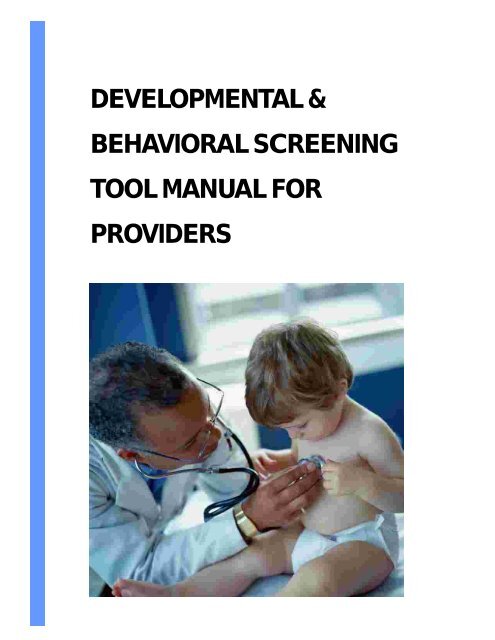
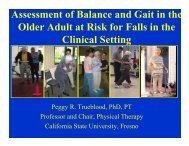
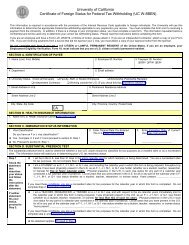
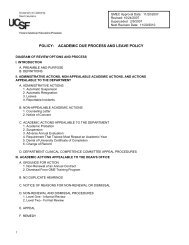
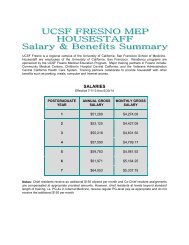
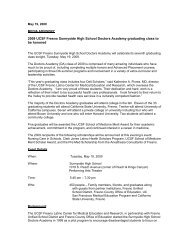
![Assistive Mobility Devices For Prevention Of Falls[1] - UCSF Fresno](https://img.yumpu.com/48127846/1/190x245/assistive-mobility-devices-for-prevention-of-falls1-ucsf-fresno.jpg?quality=85)
